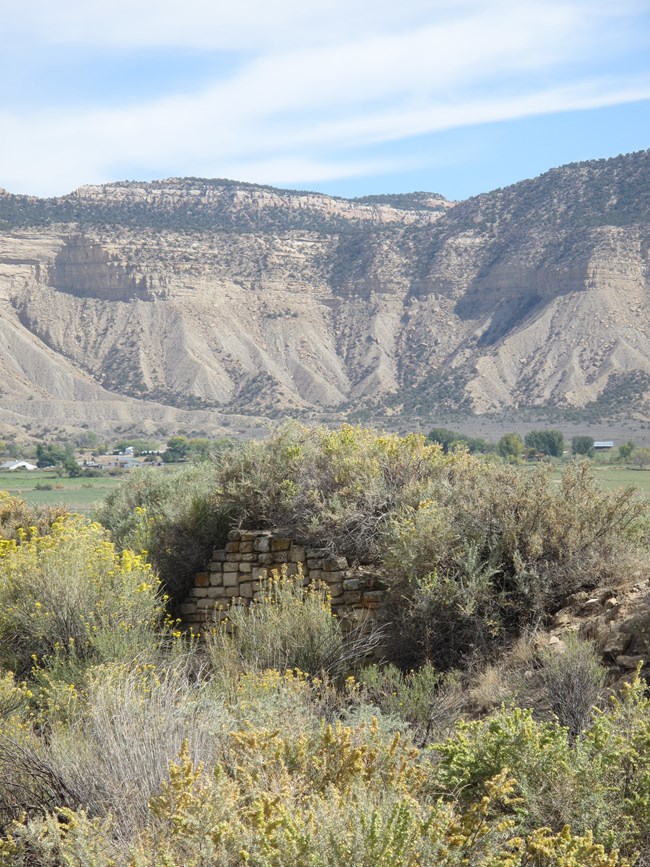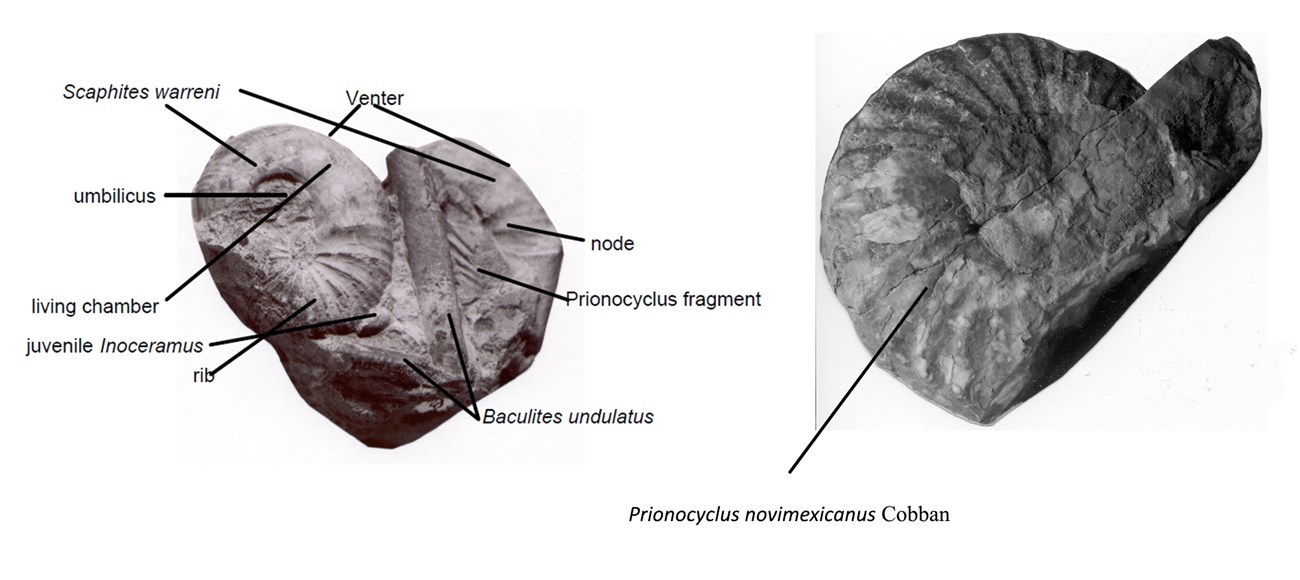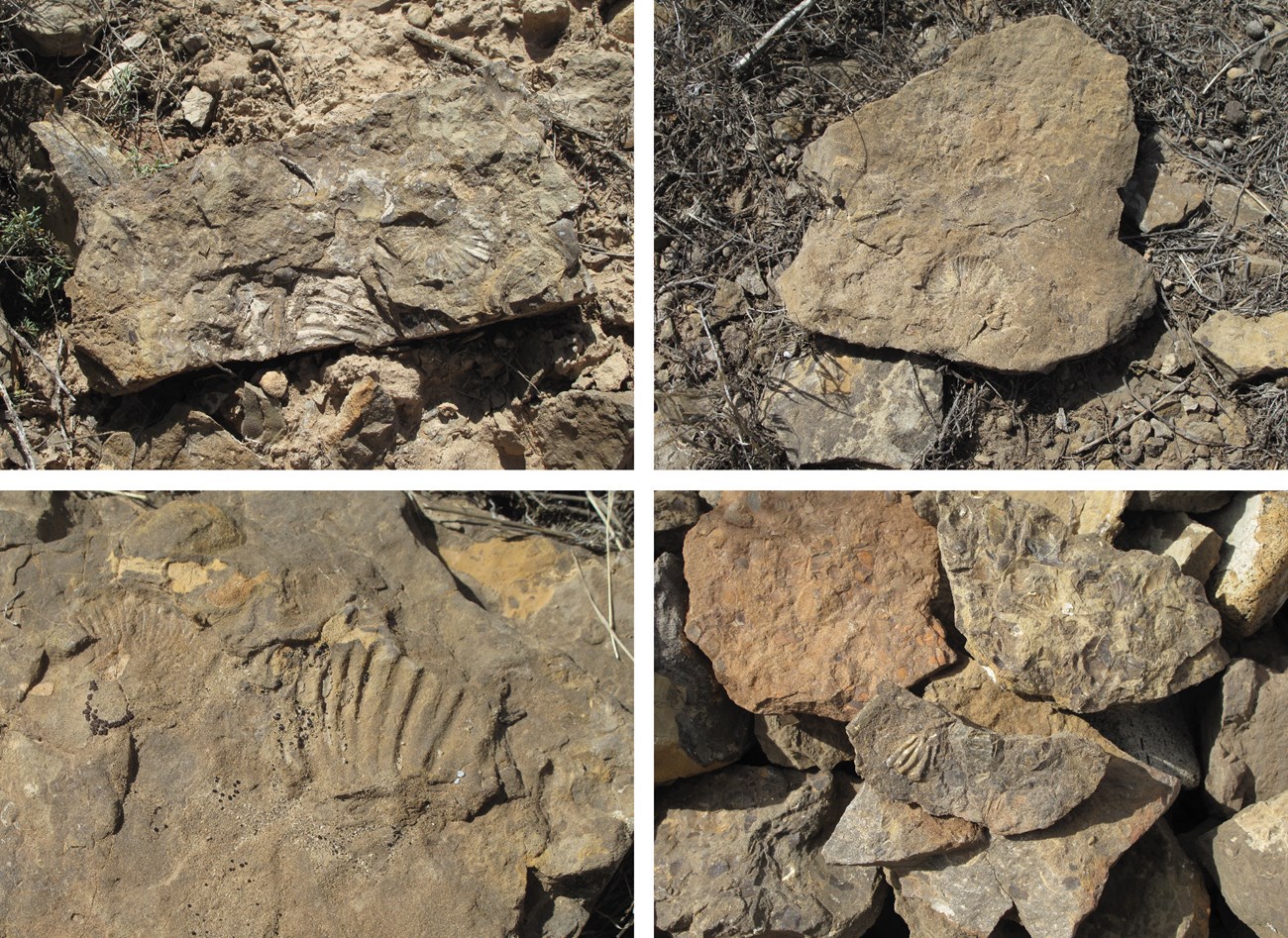Part of a series of articles titled Park Paleontology News - Vol. 13, No. 2, Fall 2021.
Article
Interconnectedness: A Closer Look at the Paleontological and Cultural Resources of Yucca House National Monument

Victoria Crystal
Scientist in Parks—Geology Assistant
NPS Geologic Resources Division

NPS photo by George San Miguel.
Most people have never heard of Yucca House National Monument (YUHO). The most common response I get when I tell people I’m working on a paleontology inventory of Yucca House is, “never heard of it. Where’s that?” And when I give my usual response of, “it’s just west of Mesa Verde,” I get the characteristic understanding, “ooohhh ok, I know where that is now.”
Located just 10 miles west of Mesa Verde National Park (MEVE), it almost seems like YUHO exists in the shadow of its larger, better-known sibling MEVE. But YUHO has its own wealth of paleontological and cultural resources that I have spent the last several months getting to know.
Like MEVE, YUHO was originally established to protect its cultural resources—archeological sites of the Ancestral Puebloan people. Unlike MEVE, however, YUHO’s archeological sites remain unexcavated in an effort to preserve the integrity of the structures and provide opportunities for future generations of archeologists.
Hundreds of years ago, approximately between 1050–1150 CE and 1225–1300 CE, Ancestral Puebloans built the structures that YUHO was later established to protect. The unexcavated archeological sites at YUHO provide evidence of the human occupation and use of the area. A number of prehistoric structures preseved within the monument include a multistory stone masonry pueblo with a well-preserved Great House, multiple towers in small plazas, a bi-wall structure, hundreds of kivas (ceremonial structures), and a well-delineated ceremonial plaza containing a great kiva. These unexcavated sites appear as a cluster of mounds on the surface, with visible walls and reconstructed walls built from blocks of local stone (Figure 1).
The long human history of the area has been shaped and influenced by the dynamic geologic features and processes present in the region. The Ancestral Puebloans likely settled at what is now YUHO because of the presence of natural springs, particularly Aztec Spring, which is situated in the center of the archeological sites. Though the springs currently have very low flows, indicated by the presence of only a small wetland, at the time the Ancestral Puebloans occupied the area, the springs must have provided enough water to sustain the population.

Base map by Scott D. Sampson, Mark A. Loewen, Andrew A. Farke, Eric M. Roberts, Catherine A. Forster, Joshua A. Smith, Alan L. Titus, 2010, and licensed under Creative Commons Attribution 4.0 International. Graphic annotated by Victoria Crystal.
Yet, the geologic features and processes in the region began influencing life long before human habitation. Millions of years ago—well before humans occupied the area—communities of ancient organisms thrived. This multimillion-year history of geology and life is recorded in the rock units that underlie the national monument; thus, although the monument is known for is archeological resources, it has rich paleontological resources as well.
The main bedrock unit at YUHO is the fossiliferous Juana Lopez Member of the Mancos Shale, which was deposited during a time when the region looked much different than it does today. Today, YUHO sits at approximately 5,800 ft above sea level in the Colorado Plateau, but 90 million years ago, during the Cretaceous Period, the Rocky Mountains did not yet exist and the area was submerged by the Western Interior Seaway, which hosted a variety of marine invertebrates (Figure 2).
There are at least six species of bivalves found in the Juana Lopez Member of the Mancos Shale at and in the vicinity of YUHO, including at least two inoceramid clams and one oyster found within the monument. There are also seven species of ammonites in three genera that have been found in the Juana Lopez Member of the Mancos Shale at or within the vicinity of YUHO. The three genera have distinct morphologies that enable them to be easily identified to the genus level, even by those unfamiliar with invertebrate paleontology. Specimens of the genus Scaphites have loosely coiled shells shaped that appear to look like the number nine. Specimens of the genus Baculites have straight or slightly curved shells; and specimens of the genus Prionocyclus have the tightly coiled or spiraled shells that even non-paleontologists often recognize as belonging to an ammonite (Figure 3).

Figure 3: Photos of YUHO fossils. Image on the left shows Scaphites warreni Meek and Hayden, and Baculites undulatus d’Orbigny. Image on the right shows Prionocyclus novimexicanus Cobban. Scaphites have loosely coiled shells shaped like the number nine. Baculites have straight or slightly curved shells. Prionocyclus have tightly coiled or spiraled shells.
Left image is Figure 10A from Griffitts (2001), and the right image is from Figure 11 in Griffitts (2001).
These fossils generally occur in well-cemented calcarenite layers of the Juana Lopez member. Calcarenite is a limestone that resembles sandstone because it is composed of carbonate grains. The Ancestral Puebloans used these fossiliferous slabs of calcarenite as building materials (Figure 4). The majority of the building stones at the YUHO archeological sites are these fossiliferous slabs; the rest are from other local rock units. The nearest outcrop of fossiliferous rock is approximately 0.25–0.5 miles west of the buildings. Presumably the Ancestral Puebloans deemed this rock well suited for their construction needs leading them to collect and transport blocks of it to use as building materials. This illustrates an example of the interconnectedness of people (human dimensions) with the geologic resources at YUHO.

NPS photo by George San Miguel.
While many fossils have been discovered in association with the archeological sites, there are likely many other fossils in the area that have yet to be discovered. A 160-acre boundary expansion is currently underway for YUHO, which will incorporate a parcel of land to the east of the current monument boundary. There is much more to be learned about the Ancestral Puebloans and invertebrate fossils of YUHO, and this new parcel will have a wealth of cultural and paleontological resources to discover and learn about in the future.
Related Links
- Mesa Verde National Park, Colorado—[Geodiversity Atlas] [Park Home]
- Yucca House National Monument, Colorado—[Geodiversity Atlas] [Park Home]
- NPS—Fossils Through Geologic Time
- NPS—Fossils and Paleontology
- NPS—Geology
Last updated: September 29, 2021
